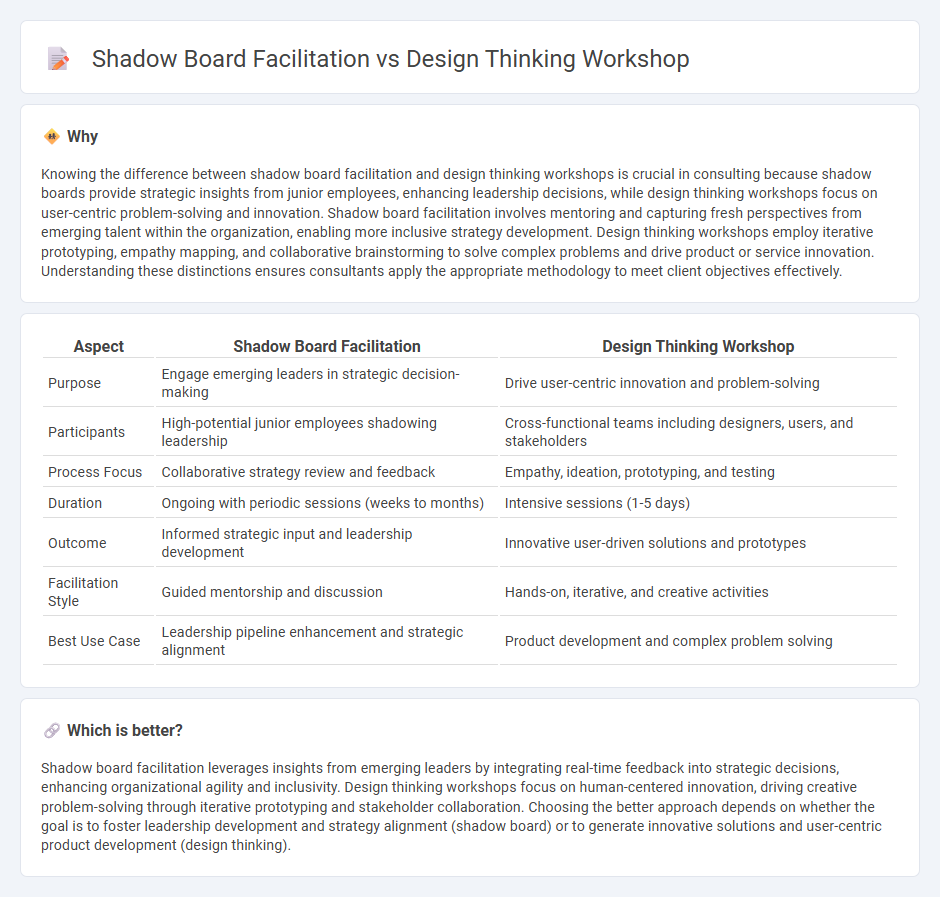
Shadow board facilitation empowers emerging leaders to actively participate in strategic decision-making, fostering innovation and organizational agility. Design thinking workshops emphasize user-centric problem-solving through empathy, ideation, and prototyping, driving creative solutions. Explore how each approach can transform your consulting outcomes and enhance team collaboration.
Why it is important
Knowing the difference between shadow board facilitation and design thinking workshops is crucial in consulting because shadow boards provide strategic insights from junior employees, enhancing leadership decisions, while design thinking workshops focus on user-centric problem-solving and innovation. Shadow board facilitation involves mentoring and capturing fresh perspectives from emerging talent within the organization, enabling more inclusive strategy development. Design thinking workshops employ iterative prototyping, empathy mapping, and collaborative brainstorming to solve complex problems and drive product or service innovation. Understanding these distinctions ensures consultants apply the appropriate methodology to meet client objectives effectively.
Comparison Table
| Aspect | Shadow Board Facilitation | Design Thinking Workshop |
|---|---|---|
| Purpose | Engage emerging leaders in strategic decision-making | Drive user-centric innovation and problem-solving |
| Participants | High-potential junior employees shadowing leadership | Cross-functional teams including designers, users, and stakeholders |
| Process Focus | Collaborative strategy review and feedback | Empathy, ideation, prototyping, and testing |
| Duration | Ongoing with periodic sessions (weeks to months) | Intensive sessions (1-5 days) |
| Outcome | Informed strategic input and leadership development | Innovative user-driven solutions and prototypes |
| Facilitation Style | Guided mentorship and discussion | Hands-on, iterative, and creative activities |
| Best Use Case | Leadership pipeline enhancement and strategic alignment | Product development and complex problem solving |
Which is better?
Shadow board facilitation leverages insights from emerging leaders by integrating real-time feedback into strategic decisions, enhancing organizational agility and inclusivity. Design thinking workshops focus on human-centered innovation, driving creative problem-solving through iterative prototyping and stakeholder collaboration. Choosing the better approach depends on whether the goal is to foster leadership development and strategy alignment (shadow board) or to generate innovative solutions and user-centric product development (design thinking).
Connection
Shadow board facilitation enhances innovation by engaging emerging leaders in real-time organizational challenges, creating a dynamic environment that aligns with the iterative, user-centered approach of design thinking workshops. Both methods emphasize collaborative problem-solving, rapid prototyping, and feedback loops to drive creative solutions and strategic decision-making. Integrating shadow boards with design thinking cultivates diverse perspectives, accelerating organizational agility and fostering continuous improvement.
Key Terms
**Design Thinking Workshop:**
Design Thinking Workshops prioritize user-centered innovation by guiding participants through empathizing, defining, ideating, prototyping, and testing solutions to complex problems. These workshops leverage interdisciplinary collaboration to foster creativity and rapidly iterate on ideas, enhancing problem-solving efficiency in diverse business contexts. Discover how Design Thinking Workshops can transform your approach to innovation and product development.
Ideation
Design thinking workshops prioritize structured ideation techniques such as brainstorming, mind mapping, and rapid prototyping to foster innovative problem-solving and human-centered solutions. Shadow board facilitation emphasizes real-time observation and collaborative idea generation by engaging younger employees in strategic discussions, encouraging fresh perspectives and diverse input. Explore how each approach uniquely enhances ideation within organizational innovation initiatives.
Prototyping
Design thinking workshops emphasize rapid prototyping to iterate solutions, encouraging hands-on experimentation and feedback loops that refine ideas quickly. Shadow board facilitation integrates prototyping by involving emerging leaders in testing strategic initiatives, blending experiential learning with organizational goals. Explore more to understand how these approaches uniquely accelerate innovation through prototyping.
Source and External Links
How To Run a Design Thinking Workshop [2024 Guide] - This guide explains that a Design Thinking workshop focuses on the five phases of Design Thinking--Empathize, Define, Ideate, Prototype, Test--to foster creative problem solving and innovation for business challenges, adaptable for varying lengths and formats with goals centered on improving team problem-solving and innovation.
How To Run An Awesome Design Thinking Workshop [2025] - This resource outlines step-by-step planning and conducting a Design Thinking workshop, including defining clear objectives (often framed as "how might we" questions), preparing the agenda, gathering materials, and guiding teams through collaborative innovation to solve product or business problems.
Design Thinking: Creating Better Customer Experiences - This professional online workshop offers practical tools to apply design thinking principles in organizations through a multi-day program covering identifying customer insights, ideation, prototyping, and overcoming barriers to innovation, taught by experts with experience across startups and Fortune 50 companies.
 dowidth.com
dowidth.com